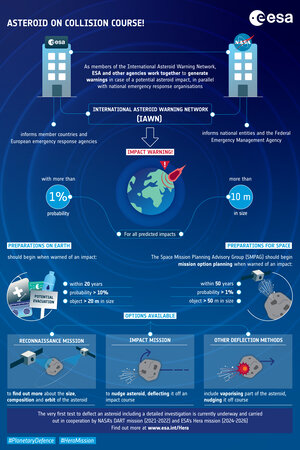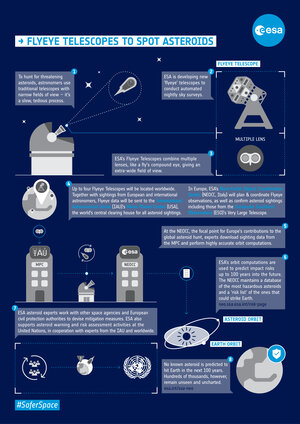

Detection: What's the risk?
Some day in the future, an asteroid might be detected heading toward our home planet. What on Earth happens next?
This infographic shows the flow of actions that would take place between global agencies and organisations, should a risky asteroid be detected.
Observations from around the globe, including from ESA's Optical Ground Station, European observatories and observers – both professional and ‘back-yard’ – and, soon, from ESA's Flyeye and Test-Bed Telescopes, are fed into the US-based Minor Planet Center - the international ‘asteroid sorting hat’.
Using the data aggregated by the Minor Planet Center, ESA's Near-Earth Object Coordination Centre and NASA's Centre for Near-Earth Object Studies determine the orbits of hazardous asteroids, and assess the risk they pose.
Finally, if an asteroid is deemed to be potentially dangerous, national civil authorities, the UN and other bodies are informed, and given support and guidance from ESA, NASA and other agencies.
Watch ‘Asteroid Impact 2028: Protecting our planet’, a dramatisation of how ESA might react if a threatening asteroid is ever discovered
Space safety at ESA
Solar activity, asteroids and artificial space debris all pose threats to our planet and our use of space.
ESA's Space Safety activities aim to safeguard society and the critical satellites on which we depend, identifying and mitigating threats from space through projects such as the Flyeye telescopes, the Lagrange space weather mission and the Hera asteroid mission.
As asteroid experts meet for the international Planetary Defense Conference, ESA is focusing on the threat we face from space rocks. How likely is an asteroid impact? What is ESA doing to mitigate impact risks? Follow the hashtag #PlanetaryDefense to find out more.
Space Safety & Security at ESA: www.esa.int/spacesafety
Planetary Defence: www.esa.int/planetarydefence
Download the posters: www.esa.int/paleblue





